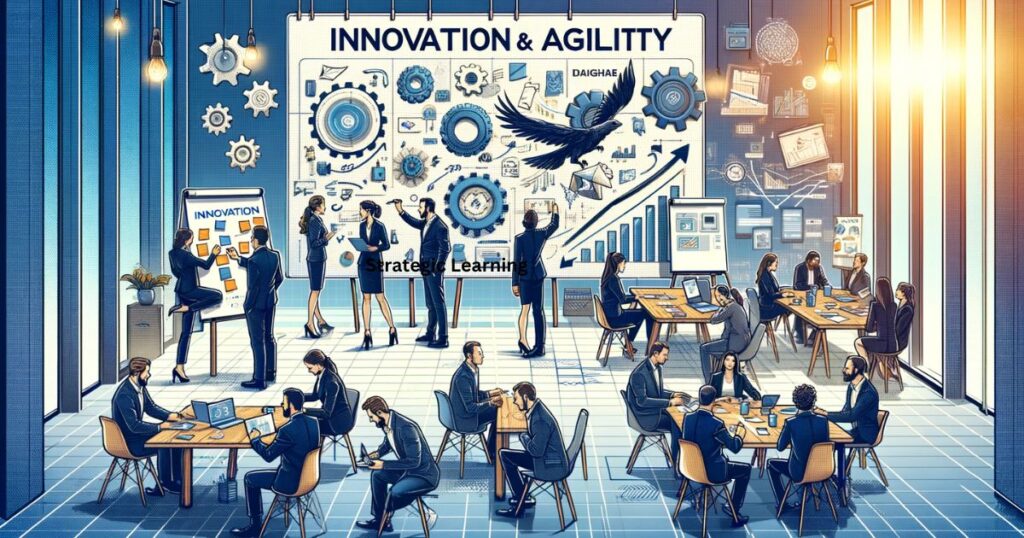15 Benefits of Creative Thinking for Workplace Leaders
Creative thinking is the ability to see beyond the obvious, connect unrelated dots, and come up with fresh, innovative ideas. It’s not just about arts or inventions; it’s about finding unique solutions to everyday challenges in the workplace.
In our rapidly evolving world, challenges can change shape overnight. Traditional problem-solving methods often fall short. Leaders need creative thinking to thrive.
It equips leaders with a versatile approach to tackle a variety of hurdles.
I’ve had the privilege of witnessing this transformation firsthand through immersive workshops designed for Filipino managers and supervisors. I’ve seen the spark of creativity ignite that leads to better decision-making, enhanced team dynamics, and a renewed passion for leadership.
So, why should leaders integrate creative thinking into their toolkit? And how do these workshops help in honing this skill? Let’s dive in and explore.
Workshop: Creativity in Everyday Work

How Creative Thinking Works
At its core, creative thinking is about breaking free from conventional patterns and venturing into the unknown, the unexplored. It’s about asking “What if?” instead of “What is?”
Our brains are wired to recognize patterns and make connections. While this is efficient for routine tasks, it can sometimes limit our perspective.
Creative thinking encourages the brain to bypass these regular routes and forge new pathways. This mental flexibility leads to unexpected and innovative solutions.
Linear vs. Creative Thinking
While linear thinking follows a step-by-step approach, creative thinking dances around, leaps forward, and occasionally takes a step back. Linear thinking is like driving from point A to point B using a well-known road.
In contrast, creative thinking is about exploring uncharted territories, finding hidden shortcuts, or even building a new road altogether.
Real-Life Examples
Consider a company faced with decreasing sales. A linear approach might look at cutting costs or increasing marketing efforts. A creative thinker, however, might explore alternative product uses, tap into a new target audience, or even reinvent the brand’s identity.
It’s this outside-the-box thinking that can transform challenges into opportunities. It looks for ways to 10x your results for half the effort.
The Value of Creative Thinking Workshops
The magic of creative thinking workshops lies in their immersive nature. They aren’t just lectures; they are hands-on experiences that challenge participants to think differently.
By presenting real-world problems and encouraging unconventional solutions, these workshops push participants out of their comfort zones, fostering growth.
In my workshops, I’ve witnessed Filipino leaders evolve. They’ve transitioned from being problem-spotters to solution-finders.
The camaraderie developed during group tasks, the brainstorming sessions, and the thrill of finding a novel solution together, all contribute to a profound change in mindset.
Right from improved team collaboration to the ability to pivot in changing market conditions, the benefits of these workshops are manifold.
Attendees not only leave with a renewed sense of purpose but also with tangible skills that have lasting impacts on their respective organizations.
In our journey ahead, we’ll delve deeper into these benefits, shedding light on why every workplace leader should embrace and champion creative thinking.
Allow me to share with you 15 ways you can make the most of immersive workshops.

1. Enhanced Problem-Solving Abilities
One of the most immediate benefits of creative thinking is enhanced problem-solving abilities. Approach issues from multiple angles so you can uncover solutions that might have otherwise remained hidden.
Help the organization navigate through complex challenges and positively impact employees by fostering a proactive approach.
Customers benefit from improved services and products born out of innovative problem-solving.
Let’s give an example.
Martin, a manager at a renowned IT company in Manila, noticed a sudden dip in the productivity of his team. Instead of resorting to traditional methods like imposing longer working hours or rigorous training sessions, he decided to adopt a creative approach.
He organized a brainstorming session where team members could openly discuss their concerns and challenges. It was revealed that most team members felt isolated working remotely, leading to decreased motivation.
Harnessing his creative thinking, Martin introduced a virtual “coffee break” session where team members could casually chat and bond. Not only did this simple move increase morale, but productivity levels also soared.
When faced with a challenge, always seek feedback. Often, the simplest solutions come from those experiencing the challenge firsthand.
Empower your team by embracing creative solutions today!
2. Improved Team Collaboration
Creative thinking fosters better team collaboration. Encourage diverse thought processes and innovative ideas so you can create an environment where every voice is heard and valued.
The ripple effect of this improved collaboration touches every facet of the organization.
Teams work more cohesively, projects move forward more smoothly, and the collective brainpower of the group is harnessed. Employees feel a greater sense of unity, leading to increased satisfaction and loyalty.
Customers benefit from a well-coordinated service, where solutions are crafted through the synergy of various expertise.
Ricardo, a manager at a fast-growing e-commerce platform, was concerned about the growing silos between different departments. Marketing was often out of sync with product development, leading to mismatched campaigns.
Instead of mandating more meetings, Ricardo employed a creative solution. He set up cross-functional workshops, where members from different departments worked together on short projects or problem-solving tasks.
The result? Departments began understanding each other’s roles better, communication improved, and the company started launching perfectly aligned campaigns.
This immersive experience allows leaders to see things differently. It helps them to see the whole, not just there “most important” parts.
Cross-functional workshops can break departmental silos, fostering understanding and unity.
Unleash the collective power of your teams with creative collaboration strategies!
3. Greater Adaptability in Changing Environments
Change is the only constant and the ability to adapt swiftly and effectively is crucial. Equip leaders with the foresight to anticipate changes and the flexibility to pivot strategies accordingly.
This adaptability is invaluable for organizations. Employees, too, benefit as they’re nurtured in an environment that embraces change, fostering resilience and a growth mindset.
For customers, they get to interact with a brand that’s always relevant, meeting their ever-evolving needs.
Lena, a manager at a travel agency, was faced with an unprecedented challenge during the global travel restrictions. With international vacations at a standstill, many would’ve seen this as a dead-end. But not Lena.
Leveraging her creative thinking, she pivoted her agency’s focus to local tourism, curating unique staycation packages and virtual travel experiences.
Her innovative approach not only kept the company afloat but introduced them to a whole new niche of local travel enthusiasts.
Perhaps, you have seen something like this during the pandemic.
Always keep an eye on industry trends and be ready to reinvent. Today’s obstacle could be tomorrow’s opportunity.
Stay ahead of the curve by embracing change with creative foresight!

4. Fostering a Culture of Innovation
One of the remarkable outcomes of creative thinking is the birth of a culture that values and nurtures innovation. Leaders who prioritize creativity pave the way for continuous ideation, experimentation, and evolution.
For organizations, this means staying competitive and leading the market with breakthrough ideas and products. Employees thrive in such environments, as they are constantly encouraged to think differently and bring fresh perspectives to the table.
Customers enjoy cutting-edge solutions tailored to meet their needs and desires.
Sofia, a manager at a consumer electronics company, found her team stuck in a cycle of iterative updates to existing products, with no real groundbreaking innovations.
Recognizing the need to shake things up, Sofia initiated ‘Innovation Fridays‘ – a day where team members were encouraged to work on any new idea, unrelated to their current projects.
The result was astounding. Not only did this lead to a slew of innovative product ideas, but it also reignited a passion for invention within the team.
You may call it any other name. What’s important is you provide leaders with an immersive experience in innovation. It makes them look forward to that day when they can bring out their genius.
Dedicate time for free thinking and experimentation. It’s in these unrestricted moments that true innovation often sparks.
Ignite the innovative spirit in your organization with creative leadership!
5. Enhanced Decision Making
Decision-making is a critical aspect of leadership. Elevates this process by allowing leaders to balance data-driven analysis with intuitive, out-of-the-box thinking.
Organizations find themselves making choices that are not only informed but also visionary.
Employees in such environments are more aligned with decisions, understanding that every choice is a blend of facts and forward-thinking.
Customers interact with a brand that’s both reliable and revolutionary, meeting their immediate needs while also anticipating their future desires.
Carlos, a manager in a retail company, was grappling with the decision to expand their physical stores amidst the digital shopping boom. Traditional data suggested focusing solely on online expansion. However, Carlos, with his creative hat on, decided to blend the physical and digital.
He launched “experience centers” – smaller physical outlets where customers could touch and feel the products but used QR codes to place orders online.
This hybrid decision led to reduced overhead costs of large stores, while still giving customers the tactile experience many still craved.
When making decisions, combine data with intuition. Sometimes, the best path forward is a blend of what’s known and what’s possible.
Make decisions that shape the future; let creative thinking be your guide!
6. Increased Employee Engagement
Employee engagement is more than just satisfaction; it’s about passion, commitment, and a sense of ownership.
Leaders who harness creative thinking often foster environments where employees feel seen, heard, and, most importantly, valued for their unique contributions.
Organizations with high employee engagement benefit from reduced turnover, higher productivity, and a more positive workplace culture. Employees enjoy their work more, feel aligned with the company’s vision, and are motivated to go the extra mile.
Customers get to interact with a brand whose employees are genuinely passionate about delivering the best, reflecting on the quality of service and products they receive.
Rosa, a manager at a software development firm, noticed a decline in her team’s enthusiasm. Instead of the standard employee surveys, Rosa got creative. She organized a “Passion Project” month, where employees were encouraged to work on any company-related project they were passionate about, outside of their usual tasks.
The outcome was extraordinary. Not only were innovative ideas brought to the table, but employees also felt a renewed sense of engagement and alignment with the company’s goals.
Allocate time for employees to pursue projects they’re passionate about. It can reignite their drive and bring forth unexpected innovations.
Foster a thriving workplace by championing creativity and passion!

7. Better Risk Management
In the world of business, risks are inevitable. However, with creative thinking, leaders can perceive these risks from various perspectives, allowing them to craft innovative solutions and strategies for mitigation.
Organizations led by creative thinkers are often better prepared for uncertainties. They can adapt and evolve strategies swiftly, ensuring minimal disruptions.
Employees, working in such proactive environments, feel more secure, knowing that the leadership is equipped to navigate challenges. Customers, meanwhile, enjoy consistency in service and offerings, even in turbulent times.
Eduardo, a manager in a logistics company, faced a challenge when a major transportation route was suddenly closed due to unforeseen circumstances. While many would resort to the obvious alternative routes (which were longer and costlier), Eduardo thought creatively.
He collaborated with local businesses, merging consignments and optimizing routes. This not only kept delivery times in check but also significantly reduced costs.
When faced with risks, think collaboratively. Sometimes, joining forces with unlikely allies can offer the best solutions.
Turn uncertainties into opportunities with the power of creative thinking!
8. Improved Conflict Resolution
Conflicts, whether interpersonal or strategic, are a natural part of any organization. Creative thinking provides leaders with the tools to approach conflicts not as barriers but as opportunities for growth, understanding, and collaboration.
Organizations that harness creative conflict resolution witness healthier team dynamics, streamlined project execution, and a more inclusive work environment.
Employees in these settings feel heard and valued, knowing that disagreements are addressed constructively.
Customers benefit from a cohesive brand experience, as internal harmony often translates to external excellence.
Miguel, a manager at a design agency, found himself mediating a disagreement between his graphics and content teams. The graphics team wanted minimalistic designs, while the content team felt it made the message unclear.
Instead of choosing one side over the other, Miguel facilitated a “design hackathon” where both teams collaborated to create hybrid designs that balanced aesthetics with clarity.
The result? Not only did they come up with a unique design language that delighted their clients, but the exercise also strengthened inter-team relationships.
Transform conflicts into collaboration opportunities. It’s a chance to merge the best of both worlds.
Resolve differences creatively and watch your organization flourish!
9. Enhanced Communication Skills
Effective communication is the bedrock of any successful organization. Enable leaders to convey ideas, visions, and strategies in compelling and innovative ways.
Organizations that prioritize creative communication enjoy clearer goal-setting, better alignment across departments, and a more engaged workforce.
Employees feel more connected, understanding the company’s direction and their role in it. Customers experience a brand that communicates with clarity and creativity, fostering trust and loyalty.
Isabella, a manager in a healthcare startup, was struggling to convey the technical aspects of their new product to a non-technical audience. Standard presentations were failing to resonate. Tapping into her creative side, Isabella decided to use storytelling.
She crafted a narrative around a patient, weaving in the product’s features and benefits through the patient’s journey.
The result was a deeply engaging presentation that not only made the audience understand but also connect emotionally with the product.
Storytelling is a powerful tool in communication. Turn data and facts into narratives to make them more relatable and memorable.
Speak the language of creativity and watch your message resonate like never before!
10. Driving Business Growth
At the heart of every organization’s aspirations is the desire for growth. Creative thinking fuels this drive, pushing boundaries and envisioning new horizons that might have seemed unreachable with conventional approaches.
Organizations under the stewardship of creative thinkers often find themselves pioneering new markets, innovating product lines, and enhancing customer experiences. Employees, as a result, enjoy a sense of accomplishment and the thrill of being part of a dynamic, forward-moving entity.
Customers, constantly at the receiving end of new and improved offerings, feel valued and excited by the brand’s evolution.
Juliana, a manager at a traditional publishing house, observed the declining trend in print media sales. While many in the industry were resigned to this decline, Juliana took it as a challenge.
Using creative thinking, she spearheaded a digital transformation, integrating Augmented Reality (AR) into their print materials. Readers could now use their smartphones to bring content to life, merging the tactile pleasure of print with the dynamic world of digital.
This bold move not only revitalized their sales but also positioned them as innovators in a traditionally conservative market.
Innovation isn’t just about technology. Sometimes, blending the old with the new can lead to groundbreaking results.
Embrace the unconventional; let creativity be your growth catalyst!

11. Attracting and Retaining Top Talent
In the competitive landscape of talent acquisition and retention, offering a unique value proposition is important..
Creative thinking in leadership not only attracts top-tier talent but also ensures they stay, motivated by an environment that values innovation and out-of-the-box thinking.
Organizations that champion creativity often boast a diverse, skilled, and passionate workforce. Employees are more likely to stick around, knowing they’re in a space that encourages growth, experimentation, and thinking differently.
For clients or customers, this means interfacing with a team that’s at the top of its game, bringing the best solutions and services to the table.
Antonio, a manager at a leading software solutions company, was facing a talent drain. His top engineers and developers were being poached by competitors offering marginally higher salaries. Rather than entering a salary war, Antonio decided to get creative.
He introduced “Innovation Weeks” – periods where teams could drop regular tasks and focus solely on their passion projects or learn a new skill.
This initiative, coupled with mentorship programs and internal innovation contests, made his company a magnet for top talent. More importantly, those who came for these unique opportunities often chose to stay, even when more lucrative offers came their way.
You can also do something similar. You can start by understanding how the 20% Rule of Google works.
Invest in your employees’ growth and passions. It’s often the intangibles, more than the salary, that make a workplace truly attractive.
Make your organization a talent magnet; nurture a creative ecosystem!
12. Promoting Continuous Learning
A cornerstone of progressive organizations is the commitment to continuous learning. Creative thinking fosters an innate curiosity, driving individuals to seek knowledge, explore new horizons, and consistently improve.
For organizations, this culture of continuous learning translates into staying updated with industry trends, adopting the latest best practices, and being ever-evolving.
Employees benefit immensely, developing both professionally and personally, ensuring they remain at the forefront of their respective domains. Customers, in turn, are served by a brand that’s always on the cutting edge, offering the latest and the best.
Luisa, a manager at a digital marketing firm, noticed a stagnation in the techniques and strategies employed by her team. Realizing the rapid pace at which digital trends evolve, she introduced “Learn & Share” sessions.
Every month, team members would dive deep into a new trend, tool, or strategy and then share their insights with the rest. This not only ensured that the entire team stayed updated but also promoted a culture of collaborative learning.
The ripple effect was immediate. The firm started offering more contemporary solutions to their clients, and team members felt a renewed sense of purpose and passion.
Encourage shared learning. When every team member becomes both a student and a teacher, growth is exponential.
Fuel the flame of curiosity; let continuous learning drive your organization’s success!
13. Boosting Organizational Morale
A positive workplace atmosphere is instrumental for overall productivity and well-being. Creative thinking, with its emphasis on inclusivity, innovation, and recognizing diverse talents, significantly boosts organizational morale.
Organizations that cultivate a creative culture witness happier, more motivated teams. There’s a palpable energy, a vibe of optimism where challenges are viewed as exciting puzzles rather than daunting obstacles.
Employees feel valued, knowing their unique ideas and perspectives are cherished. Customers sense this positive morale in their interactions, leading to better relations and increased brand loyalty.
Ana, a manager at a mid-sized manufacturing unit, observed a decline in team spirit after a series of routine and monotonous quarters.
To rekindle the enthusiasm, Ana introduced “Creative Mondays” – a day where teams would brainstorm, participate in workshops, or even engage in team-building games that fostered creativity.
The transformation was evident. Mondays, usually dreaded, became the most anticipated day of the week. The renewed morale led to enhanced teamwork, better productivity, and a happier workplace.
Infuse regular workdays with creative breaks. These moments of relaxation and creativity can recharge and inspire teams.
Elevate your team’s spirit; let creativity be the beacon of positivity!
14. Future-Proofing the Organization
In an era defined by rapid technological advancements and shifting market dynamics, the ability to anticipate and prepare for the future is invaluable.
Creative thinking empowers leaders to envision potential scenarios and design strategies that ensure sustainability and success.
Organizations that prioritize creative foresight are better equipped to navigate market uncertainties, making them resilient to disruptions. Employees in such environments are continually upskilled and trained, ensuring they remain relevant in their fields.
Customers benefit from a brand that not only meets their present needs but also anticipates and evolves with their future demands.
Diego, a manager at a traditional banking institution, recognized the burgeoning trend of digital finance solutions. While the bank had a solid brick-and-mortar presence, Diego foresaw the impending digital wave.
Harnessing creative thinking, he championed the development of user-friendly mobile banking apps and integrated AI-driven customer support.
The proactive move positioned the bank favorably against newer fintech competitors and ensured they retained their customer base while attracting tech-savvy millennials.
Regularly allocate time for “future brainstorming” sessions, allowing teams to discuss, debate, and design for upcoming trends.
Be the architect of your organization’s future with visionary creative thinking! Champion innovation in training.
15. Cultivating Personal Leadership Growth
Every leader, irrespective of their experience or success, has room for growth. Creative thinking acts as a catalyst, propelling leaders towards introspection, self-improvement, and a broader understanding of their leadership style.
Organizations helmed by leaders committed to personal growth are often more adaptable, innovative, and have a clearer vision. Employees in such setups are inspired, seeing firsthand the value of continuous self-improvement.
Customers, indirectly, benefit from leaders who are always striving to be better, as this commitment to excellence often permeates the entire organization.
Carmen, a manager with over two decades of experience in a leading pharmaceutical company, could have easily rested on her laurels. However, she viewed her role as a journey, not a destination.
Embracing creative thinking, Carmen routinely attended workshops outside her field, from design thinking to narrative storytelling.
Each workshop, while not directly related to pharmaceuticals, enhanced her leadership perspective, enabling her to approach challenges differently and inspire her team with varied strategies.
This commitment to personal growth created a ripple effect. Her team was more innovative, and the company consistently outpaced competitors in creative problem-solving.
Diversify your learning. Sometimes, the most profound leadership insights come from unexpected places.
Embark on your personal growth journey; let creativity be your compass!

Creative Leadership Workshop
There are many benefits to creative thinking workshops. They impact every aspect of an organization, from its core vision to its daily operations, from its leaders to its customers.
Yet, reading about it is just the first step. The real magic happens when these principles are put into practice.
If the transformative power of creative thinking has inspired you, there’s no better time than now to act.
Consider designing a creative leadership workshop for their managers and supervisors. Not only will it equip them with invaluable skills, but it will also usher in a wave of innovation, collaboration, and growth.
Creative leaders often chart the path forward, turning challenges into opportunities and visions into realities.
Take the first step today by investing in a workshop that can reshape tomorrow!
Read: Think Inside the Box


Responses